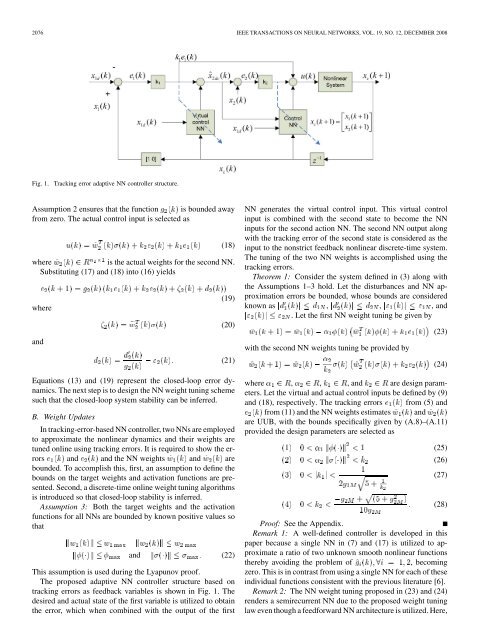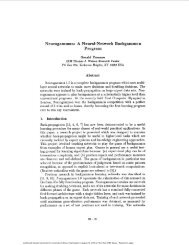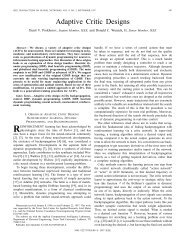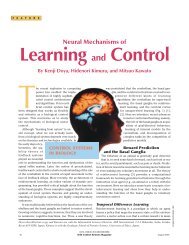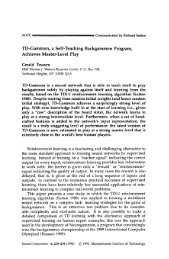Neural-Network-Based State Feedback Control of a ... - IEEE Xplore
Neural-Network-Based State Feedback Control of a ... - IEEE Xplore
Neural-Network-Based State Feedback Control of a ... - IEEE Xplore
You also want an ePaper? Increase the reach of your titles
YUMPU automatically turns print PDFs into web optimized ePapers that Google loves.
2076 <strong>IEEE</strong> TRANSACTIONS ON NEURAL NETWORKS, VOL. 19, NO. 12, DECEMBER 2008<br />
Fig. 1. Tracking error adaptive NN controller structure.<br />
Assumption 2 ensures that the function is bounded away<br />
from zero. The actual control input is selected as<br />
(18)<br />
where<br />
is the actual weights for the second NN.<br />
Substituting (17) and (18) into (16) yields<br />
where<br />
and<br />
(19)<br />
(20)<br />
(21)<br />
Equations (13) and (19) represent the closed-loop error dynamics.<br />
The next step is to design the NN weight tuning scheme<br />
such that the closed-loop system stability can be inferred.<br />
B. Weight Updates<br />
In tracking-error-based NN controller, two NNs are employed<br />
to approximate the nonlinear dynamics and their weights are<br />
tuned online using tracking errors. It is required to show the errors<br />
and and the NN weights and are<br />
bounded. To accomplish this, first, an assumption to define the<br />
bounds on the target weights and activation functions are presented.<br />
Second, a discrete-time online weight tuning algorithms<br />
is introduced so that closed-loop stability is inferred.<br />
Assumption 3: Both the target weights and the activation<br />
functions for all NNs are bounded by known positive values so<br />
that<br />
and (22)<br />
This assumption is used during the Lyapunov pro<strong>of</strong>.<br />
The proposed adaptive NN controller structure based on<br />
tracking errors as feedback variables is shown in Fig. 1. The<br />
desired and actual state <strong>of</strong> the first variable is utilized to obtain<br />
the error, which when combined with the output <strong>of</strong> the first<br />
NN generates the virtual control input. This virtual control<br />
input is combined with the second state to become the NN<br />
inputs for the second action NN. The second NN output along<br />
with the tracking error <strong>of</strong> the second state is considered as the<br />
input to the nonstrict feedback nonlinear discrete-time system.<br />
The tuning <strong>of</strong> the two NN weights is accomplished using the<br />
tracking errors.<br />
Theorem 1: Consider the system defined in (3) along with<br />
the Assumptions 1–3 hold. Let the disturbances and NN approximation<br />
errors be bounded, whose bounds are considered<br />
known as , , , and<br />
. Let the first NN weight tuning be given by<br />
with the second NN weights tuning be provided by<br />
(23)<br />
(24)<br />
where , , , and are design parameters.<br />
Let the virtual and actual control inputs be defined by (9)<br />
and (18), respectively. The tracking errors from (5) and<br />
from (11) and the NN weights estimates and<br />
are UUB, with the bounds specifically given by (A.8)–(A.11)<br />
provided the design parameters are selected as<br />
(25)<br />
(26)<br />
(27)<br />
(28)<br />
Pro<strong>of</strong>: See the Appendix.<br />
Remark 1: A well-defined controller is developed in this<br />
paper because a single NN in (7) and (17) is utilized to approximate<br />
a ratio <strong>of</strong> two unknown smooth nonlinear functions<br />
thereby avoiding the problem <strong>of</strong><br />
, becoming<br />
zero. This is in contrast from using a single NN for each <strong>of</strong> these<br />
individual functions consistent with the previous literature [6].<br />
Remark 2: The NN weight tuning proposed in (23) and (24)<br />
renders a semirecurrent NN due to the proposed weight tuning<br />
law even though a feedforward NN architecture is utilized. Here,


